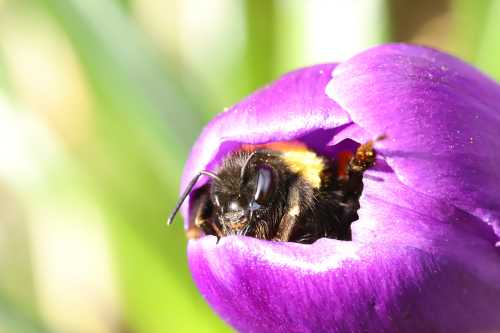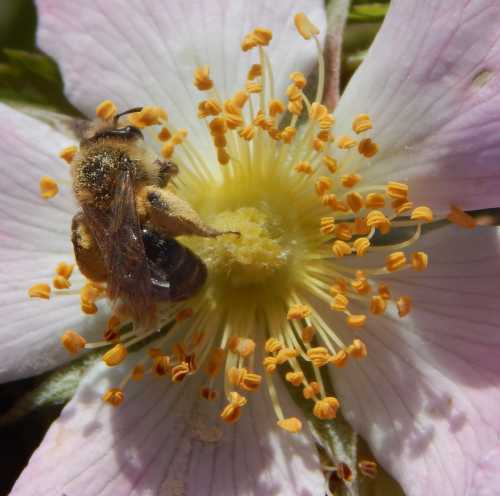Is There A Bee-friendly Clematis?
Is Clematis good for bees? As with other flowering plants and shrub, it depends which variety you buy.
Which Clematis are good for bees and pollinators?
I have to admit, I have made my own mistakes with Clematis, causing me to be cautious, and as you'll see from my notes below, only after some research do I propose particular varieties.
In my experience, despite wanting to select a bee-friendly Clematis, it is actually very easy to get it wrong, and not all of them attract bees with nectar and pollen. I also see some recommendations on various websites, that I am personally unconvinced about.
So, I wish to state upfront: if you want to be absolutely certain of planting something of value, personally I think there are better climbing plants for bees and pollinators.
I have experimented with supposedly bee-friendly varieties of Clematis, yet have seen little evidence of interest from bees.
Still, if you are very much attached to having Clematis in your garden, here are several varieties you could try - but I'm not promising they'll be favourites with pollinators.
However, if you have experience with any of the following, and wish to report success, I'd be grateful if you would contact me.
'Potentially' Bee-friendly Clematis
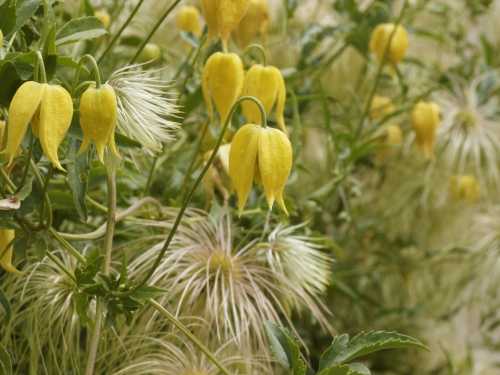 Clematis tangutica - 'Bill MacKenzie'
Clematis tangutica - 'Bill MacKenzie'1. Clematis tangutica - 'Bill MacKenzie'
Some people report that Clematis tangutica - 'Bill MacKenzie' is visited by bees and pollinators.
It is a vigorous grower that can reach 10 - 15 ft, so you'll need plenty of space and good structural support for this climber, which flowers July - September.
The flowers are followed by an abundance of long-lasting silky flowerheads.
I am grateful to John from the UK for providing this feedback:
"Hello,
Clematis Rehderiana is an excellent late flowering variety that I have found is loved by bumble bees in particular.
'Clematis Tangutica My Angel' is superb for bees, but is rampant and seedlings will pop up any where.
I have no idea why this is more attractive to bees rather than any other Tangutica (I have the yellow flowering variety too), though it flowers much more profusely.
Kind regards John"
2. Clematis cirrhosa - evergreen clematis
The first time I tried Clematis in my garden was, as I write, about 20 years ago. I selected a winter-flowering evergreen, Clematis cirrhosa.
In theory, it could provide food for bees and pollinators in winter.
However, it is rather vigorous, although some varieties more so than others.
Depending on which Clematis cirrhosa you choose, they may begin to flower from around November to February.
However, experience is a great teacher, and nowadays I would be much more careful in my choice of plants for a small garden like ours. Personally, I would only choose this climber if I had a good, sturdy wall, perhaps one I was keen to cover. There are no 'spare walls' in my garden.
Eventually, I had to get rid of it. I now have other climbers, including another Clematis - see below!
3. Clematis Montana - possibly certain varieties
Firstly, I want to state that I have one variety of Clematis montana in my garden, and it's growing over a wooden arch. I'm not convinced of its value to bees, and its presence in my garden pre-dates this website.
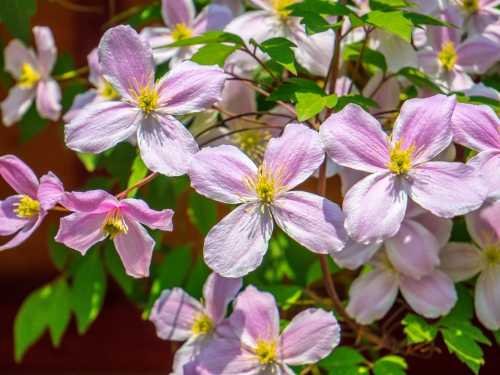 If you want the lovely flowers of Clematis montana, and you want to attract bees, be sure to select the variety carefully.
If you want the lovely flowers of Clematis montana, and you want to attract bees, be sure to select the variety carefully.It's a lovely climber that flowers in spring, and was sold to me complete with a 'wildlife and pollinator friendly' tag.
But I have yet to see a single bee visit a flower, despite being an observer of all things 'bee' in my garden.
Believe me, I have actively looked out for such an event. At most, I have seen a few hover flies visiting the pretty blooms every now and then. Yes of course, hover flies are pollinators ... but I was hoping to see bees!
The problem is, I am now so attached to the plant that I can hardly bring myself to cut it down. I remind myself that I have other bee-friendly climbers (e.g. Jasmine) and so can allow myself this treat.
Yet I know that if it should ever be replaced, it will be with something that is a reliable provider of nectar and / or pollen for bees.
However, apparently, there are a couple of genuinely bee-friendly varieties of this lovely climber - or so I understand from very reputable sources - and perhaps I was just unlucky.
That said, I cannot give you my personal guarantee. But, if you are keen to add this climber into your garden, you could consider Clematis montana 'Fragrant Spring'. As suggested by the name, it has scented flowers, which may help to attract pollinators.
I might add that my own Clematis montana has no fragrance at all.
4. Clematis Diana's Delight
This summer to early autumn flowering Clematis is said to provide pollen for bees.
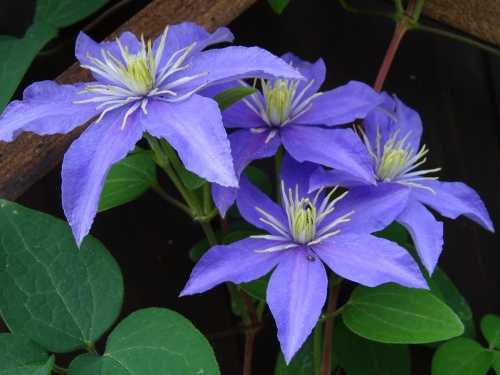
The large flowers change from violet or purple, then to blue. It can reach around 6.5ft in height.
5. Clematis heracleifolia - tube clematis
Clematis can actually be climbers, shrubs or scramblers.
If you'd like to try something a bit different, then Clematis heracleifolia is a deciduous, scrambling sub-shrub, with clusters of blue, tubular flowers.
Is Clematis 'Bee's Jubilee' attractive to bees?
Despite it's name, I have found no evidence to suggest that Clematis Bee's Jubilee is attractive to bees or pollinators.
Create a
lawn for bees
If you found this page helpful or interesting, I'd really be grateful if you would share it with others - if not this page, perhaps another, such as Gardening For Bees.
Thank you so much :) .
